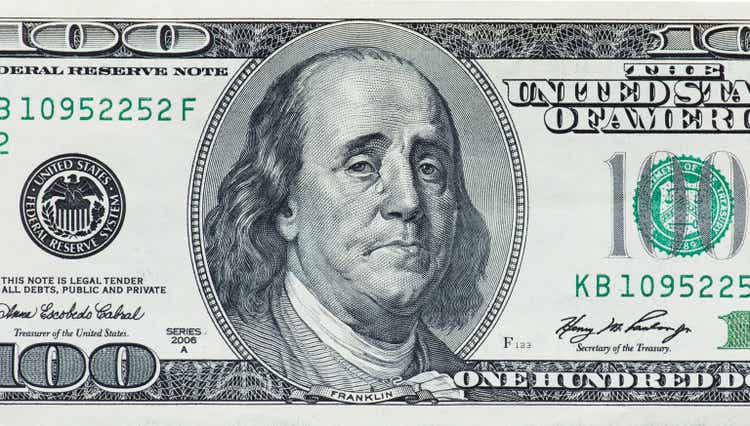mikolajn/iStock via Getty Images
“Basically, everything is hinging on what the Fed may or may not do,” said Fahad Kamal, chief investment officer at Kleinwort Hambros as quoted in the Wall Street Journal.
The jobs report came in this week. It was stronger than expected. The response of the stock market was that this would cause the Federal Reserve to reduce the size of its increase in the policy rate of interest.
Stocks dropped.
But, then maybe not.
“Investors picked up on some mixed signals in the report as they digested it, such as a decline in the average workweek for private-sector employees.”
And, stocks rose.
What is the Fed going to do? What is the Fed going to do? What is the Fed going to do?
Do you think that the Federal Reserve has become too important in the picture?
This is what I was taught as a young professional.
The Federal Reserve Throws Lots of “….” Against the Wall To See What Sticks
If too much attention is being paid to the Fed, then the Federal Reserve has “screwed up.”
If the Fed is the major focus of investors instead of the economy, then the Federal Reserve has gone beyond where it should have gone.
In situations like this, the Federal Reserve must get out of the way and let the economy adjust back into control.
Unfortunately, there may be a lot of pain that accompanies such a re-adjustment.
The economy is in disequilibrium and now must resolve itself.
And, what has the Federal Reserve done that has produced such a result?
Well, in recent posts I have been arguing that the Federal Reserve, in trying to save the economy from the spread of the Covid-19 pandemic created a bubble.
From December 2019 to December 2020, the Federal Reserve, in fighting the spreading pandemic, generate a 24.8 percent increase in the M2 money stock.
In numbers, the M2 money stock rose by $3.8 trillion!
From December 2020 to December 2021, the M2 money stock rose a further 12.4 percent.
In numbers, the m2 money stock rose by $2.4 trillion!
These numbers are now counted amongst the historical highs for the series.
Bubble?
Money was flooding all over the place!
Stock prices rose.
Housing prices rose.
The (relatively) new vehicle, the “blank check company” or the Special Purpose Acquisition Company or SPAC, boomed.
Bitcoin went from around a price of $10,000 to one around $67,500.
A bubble?
A Bubble
Well, look at the other side of the picture.
Through the fall of 2021, the Federal Reserve began to build its case of fighting the inflation that had arisen.
Another bubble?
The Federal Reserve moved to the other side of the situation. It was time to “pull in the reins”. It was time to stop serving “drinks.” It was time to fight inflation.
The effective Federal Funds rate has risen from 0.07 percent to its current level of 3.83 percent with another 50 basis point rise in its December future.
Reserve balances with commercial banks, a proxy for “excess reserves” in the banking system have dropped by around $850.0 billion since the middle of March 2022.
The year-over-year rate of growth of the M2 money stock dropped to 1.3 percent in October, the most recent data available. This growth rate is expected to go negative in the near future.
The S&P 500 Stock Index hit a historical high on January 3, 2022 and has been in decline ever since.
The price of bitcoin hit its historical high on November 8 at around $67,500 and has declined since with the latest price around $17,000.
The companies FTX and BlockFi have gone into bankruptcy and many more “new” companies that grew rapidly when the bubble was growing are now facing failure as the bubble is shrinking.
The blank check companies also seem to be “on the ropes” with many deals being dropped along with other indications that the market is no longer making many deals.
The Future
So, the “bubble” seems to be collapsing on its downside.
We do not yet know what the impact of this “fallout” might be.
It does seem, however, that there are other potential “dropouts” waiting out in the wings.
Investors in “new” companies seem to be re-examining what they have put their money into. Many seem to be drawing out, or, on the verge of drawing out.
This is a market condition the Fed has not yet experienced in the current period. But, it could be coming in the near future.
It seems whatever scenario we raise up has the Federal Reserve playing some kind of role in the evolution of this fight against disequilibrium.
It is not a pretty sight.
But, it looks as if 2023 will be dominated by more concentration on the Federal Reserve and what it is doing or what it might do.
The economy?
Not as important as the Fed and what the Fed will do in different possibilities.
This is exactly where we do not want to be. This is not where the Fed wants us to be.
And, yet, that seems to be exactly where we are.
The focus is on the Fed and will continue to be there for some period of time.


Be the first to comment